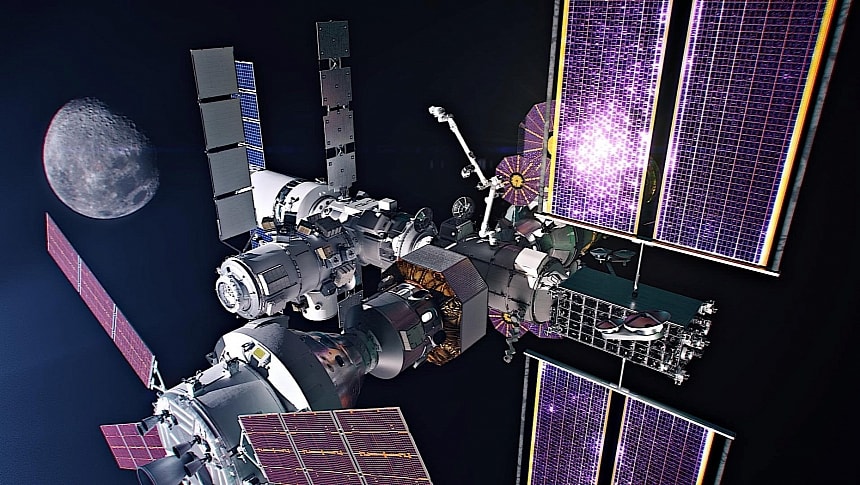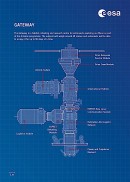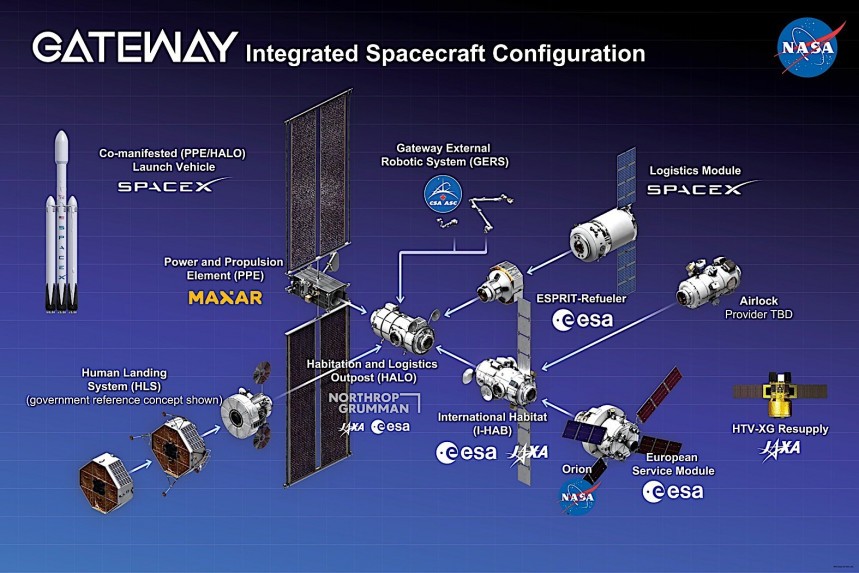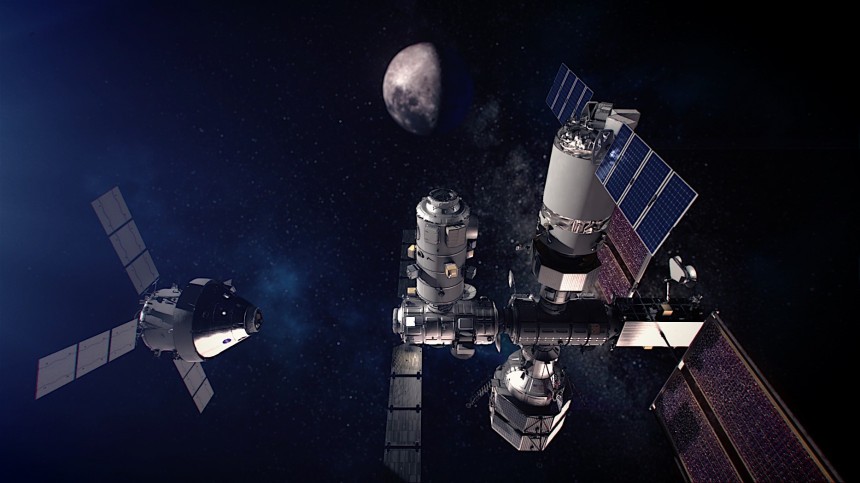Ever since Keanu Reeves had the "breathtaking” exchange with one of his fans at E3 in 2019, one has to take extra care in what context the word is used, as the bar was set pretty high. Yet that's the only word I'd use to describe this image of the fully assembled Gateway space station released by NASA, but also the details that come with it.
Gateway is the name chosen by the American space agency and its partners for an orbital station that will be built in orbit around the Moon. Plans for it were announced as far back as 2018, long before the Artemis Moon exploration launched its first mission.
The official name for the outpost was back then the Lunar Orbital Platform-Gateway, and the reasons for building it were pretty simple: facilitate the exploration of the lunar surface by Artemis astronauts, and later on serve as a staging post for missions to Mars. Regular science for the benefit of Earth as it's done on the International Space Station is also on the table.
The structure is a collaborative effort between the state and private sectors, but also between nations. Contributing to it will be agencies from North America, Japan, and Europe (NASA, CSA, JAXA, ESA), as well as private contractors like SpaceX, Maxar, or Northrop Grumman.
From a hardware point of view the station looks a tad more complex than the ISS, but at first glance it doesn't seem that way, as just three elements will comprise the backbone of the outpost: the Power and Propulsion Element (PPE, made by Maxar), the Habitation and Logistics Outpost (HALO, provided by Northrop Grumman), and the Lunar International Habitat (Lunar I-HAB, supplied by ESA).
But these will come with docking ports for a variety of spacecraft, including the Artemis program Orion, the SpaceX Human Landing System (HLS) and a logistics module, and a European refueler. And they'll also have to serve entirely different needs than the ISS.
When fully assembled, Gateway will comprise enough space for a crew of four to live, work, and prepare for lunar surface missions. Science instruments will also be aplenty on board.
The complexity of the station will require multiple launches to get it all ready for action. And it will all start in 2025 with the launch of the first two elements of the station, the PPE and HALO, on board a SpaceX Falcon Heavy rocket. Later on, the main rocket of the Artemis program, the Space Launch System in Block 1B configuration, will join the party.
Along with the release of this image (main photo) showing the completed station, NASA also gave us a preview of what to expect from the assembly process of the Gateway.
As said, a Falcon Heavy will launch with the PPE and HALO for lunar orbit sometime in 2025, but it won't reach it sooner than a year or so after departure. An extended stay in space is required because the spaceship carrying the two modules will rely mostly on solar-electric propulsion and the gravity of the Earth, Moon, and Sun to reach the Moon.
Once at their destination, the connected modules (they will launch linked to one another) will enter the designated orbit and will start performing checks to get themselves ready for the arrival of the I-Hab module.
This one will leave our planet with the Artemis IV mission sometime in 2028. That's a group of four astronauts that will become the second to set foot on the Moon (Artemis III's people will do that in 2026), but the first to actually use the Gateway for their mission.
These guys (and a gal) will become the first-ever occupants of the station, but they'll not be going up there to party. It is this crew that will bring the station fully online, and get the hardware ready for lunar surface exploration.
If everything checks out, two of the astronauts will go down to the surface for a six-day stay, aided by the pre-positioned SpaceX landing system, while the other two will remain on board the Gateway to continue setup and conduct research.
The Gateway will be positioned in such a way that its oval orbit takes it over the Moon's poles. It is also an orbit that facilitates unique views of the Earth and the Sun, and opens up deep space for study.
Along with the Moon space station, NASA will also be debuting new pieces of hardware for space exploration. Here on Earth, a new mobile launcher will become operational. 40 feet (12 meters) taller than the current gear and capable of carrying more weight, it was specifically designed to launch the SLS Block 1B, which will debut on the Artemis IV mission as well (you can find a detailed story on that rocket here).
The SpaceX Dragon XL logistics module will also make its grand entrance into the Artemis program, as it will be used to carry experiments and supplies. Two kinds of SpaceX Starships, including the human landing system, will aid in building and operating the Gateway.
The official name for the outpost was back then the Lunar Orbital Platform-Gateway, and the reasons for building it were pretty simple: facilitate the exploration of the lunar surface by Artemis astronauts, and later on serve as a staging post for missions to Mars. Regular science for the benefit of Earth as it's done on the International Space Station is also on the table.
The structure is a collaborative effort between the state and private sectors, but also between nations. Contributing to it will be agencies from North America, Japan, and Europe (NASA, CSA, JAXA, ESA), as well as private contractors like SpaceX, Maxar, or Northrop Grumman.
From a hardware point of view the station looks a tad more complex than the ISS, but at first glance it doesn't seem that way, as just three elements will comprise the backbone of the outpost: the Power and Propulsion Element (PPE, made by Maxar), the Habitation and Logistics Outpost (HALO, provided by Northrop Grumman), and the Lunar International Habitat (Lunar I-HAB, supplied by ESA).
But these will come with docking ports for a variety of spacecraft, including the Artemis program Orion, the SpaceX Human Landing System (HLS) and a logistics module, and a European refueler. And they'll also have to serve entirely different needs than the ISS.
When fully assembled, Gateway will comprise enough space for a crew of four to live, work, and prepare for lunar surface missions. Science instruments will also be aplenty on board.
Along with the release of this image (main photo) showing the completed station, NASA also gave us a preview of what to expect from the assembly process of the Gateway.
As said, a Falcon Heavy will launch with the PPE and HALO for lunar orbit sometime in 2025, but it won't reach it sooner than a year or so after departure. An extended stay in space is required because the spaceship carrying the two modules will rely mostly on solar-electric propulsion and the gravity of the Earth, Moon, and Sun to reach the Moon.
Once at their destination, the connected modules (they will launch linked to one another) will enter the designated orbit and will start performing checks to get themselves ready for the arrival of the I-Hab module.
This one will leave our planet with the Artemis IV mission sometime in 2028. That's a group of four astronauts that will become the second to set foot on the Moon (Artemis III's people will do that in 2026), but the first to actually use the Gateway for their mission.
These guys (and a gal) will become the first-ever occupants of the station, but they'll not be going up there to party. It is this crew that will bring the station fully online, and get the hardware ready for lunar surface exploration.
The Gateway will be positioned in such a way that its oval orbit takes it over the Moon's poles. It is also an orbit that facilitates unique views of the Earth and the Sun, and opens up deep space for study.
Along with the Moon space station, NASA will also be debuting new pieces of hardware for space exploration. Here on Earth, a new mobile launcher will become operational. 40 feet (12 meters) taller than the current gear and capable of carrying more weight, it was specifically designed to launch the SLS Block 1B, which will debut on the Artemis IV mission as well (you can find a detailed story on that rocket here).
The SpaceX Dragon XL logistics module will also make its grand entrance into the Artemis program, as it will be used to carry experiments and supplies. Two kinds of SpaceX Starships, including the human landing system, will aid in building and operating the Gateway.















